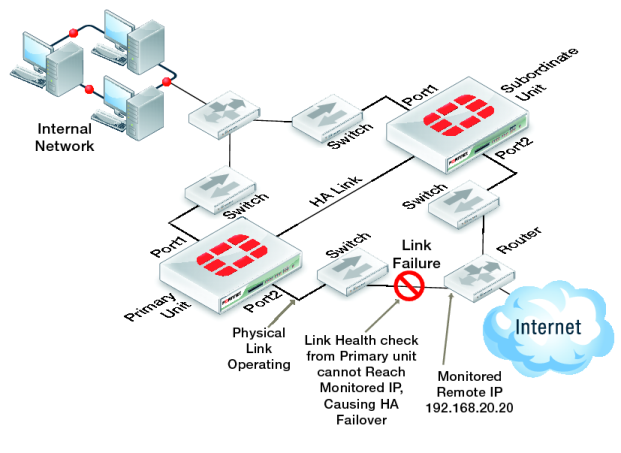Remote link failover
Remote link failover (also called remote IP monitoring) is similar to HA port monitoring and link health monitoring (also known as dead gateway detection). Port monitoring causes a cluster to failover if a monitored primary unit interface fails or is disconnected. Remote IP monitoring uses link health monitors configured for FortiGate interfaces on the primary unit to test connectivity with IP addresses of network devices. Usually these would be IP addresses of network devices not directly connected to the cluster. For example, a downstream router. Remote IP monitoring causes a failover if one or more of these remote IP addresses does not respond to link health checking.
By being able to detect failures in network equipment not directly connected to the cluster, remote IP monitoring can be useful in a number of ways depending on your network configuration. For example, in a full mesh HA configuration, with remote IP monitoring, the cluster can detect failures in network equipment that is not directly connected to the cluster but that would interrupt traffic processed by the cluster if the equipment failed.
In the simplified example topology shown in
Figure 162, the switch connected directly to the primary unit is operating normally but the link on the other side of the switches fails. As a result traffic can no longer flow between the primary unit and the Internet.
To detect this failure you can create a link health monitor for port2 that causes the primary unit to test connectivity to 192.168.20.20. If the health monitor cannot connect to 192.268.20.20 the cluster to fails over and the subordinate unit becomes the new primary unit. After the failover, the health check monitor on the new primary unit can connect to 192.168.20.20 so the failover maintains connectivity between the internal network and the Internet through the cluster.
To configure remote IP monitoring
1. Enter the following commands to configure HA remote monitoring for the example topology.
• Enter the pingserver-monitor-interface keyword to enable HA remote IP monitoring on port2.
• Leave the pingserver-failover-threshold set to the default value of 5. This means a failover occurs if the link health monitor doesn’t get a response after 5 attempts.
• Enter the pingserver-flip-timeout keyword to set the flip timeout to 120 minutes. After a failover, if HA remote IP monitoring on the new primary unit also causes a failover, the flip timeout prevents the failover from occurring until the timer runs out. Setting the pingserver‑flip‑timeout to 120 means that remote IP monitoring can only cause a failover every 120 minutes. This flip timeout is required to prevent repeating failovers if remote IP monitoring causes a failover from all cluster units because none of the cluster units can connect to the monitored IP addresses.
config system ha
set pingserver-monitor-interface port2
set pingserver-failover-threshold 5
set pingserver-flip-timeout 120
end
2. Enter the following commands to add a link health monitor for the port2 interface and to set HA remote IP monitoring priority for this link health monitor.
• Enter the detectserver keyword to set the health monitor server IP address to 192.168.20.20.
• Leave the ha-priority keyword set to the default value of 1. You only need to change this priority if you change the HA pingserver-failover-threshold. The ha-priority setting is not synchronized among cluster units.
| The ha-priority setting is not synchronized among cluster units. So if you want to change the ha-priority setting you must change it separately on each cluster unit. Otherwise it will remain set to the default value of 1. |
• Use the interval keyword to set the time between link health checks and use the failtime keyword to set the number of times that a health check can fail before a failure is detected (the failover threshold). The following example reduces the failover threshold to 2 but keeps the health check interval at the default value of 5.
config system link-monitor
edit ha-link-monitor
set server 192.168.20.20
set srcintf port1
set ha-priority 1
set interval 5
set failtime 2
end
| You can also do this from the web‑based manager by going to Router > Static > Settings > Link Health Monitor, selecting Create New and set Interface to port2, Probe Type to Ping, Server to 192.168.20.20, Probe Interval to 5, Failure Threshold to 2 and HA Priority to 1. |


